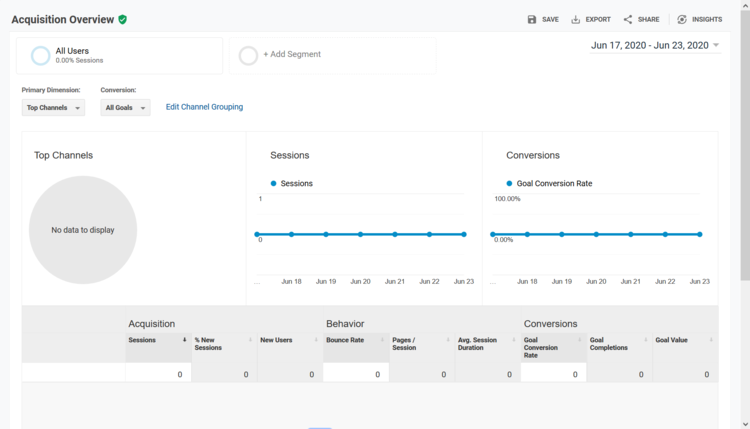Content marketing can provide you with numerous marketing and networking opportunities. It can assist you in developing beneficial long-term relationships with your target audience.
Blogging is an important aspect of content marketing, but it’s more than just sitting down at your computer and scribbling down some odd thoughts. Instead, once you’ve entered the world of content marketing, your blog and videos should have defined purposes and objectives in mind.
How Do You Measure Content Performance?
Not every company will track the same KPIs. That’s ok. If some companies want to focus on direct sales while others only want to generate brand awareness, they’ll naturally track stats.
The metrics you use should be relevant to your objectives. Businesses focused on sales should utilize Google Analytics to set up conversion tracking to evaluate which material is most helpful. Observing patterns of behavior on the site and in blog articles would also be useful.
Meanwhile, someone attempting to establish brand recognition should check for an increase in the number of backlinks to their site as well as traffic from referral sources like as social media, since this suggests that more people are sharing the material elsewhere.
Set your goals and establish how you’ll measure them before deciding on the most critical metrics for your campaigns.
What are Key Metrics for Content Marketing?
1. Traffic
The website for your company is crucial to your inbound marketing activities. It’s where you keep the content that attracts visitors and transforms them into paying customers.
Monitoring your website’s traffic is one of the simplest techniques to determine its effectiveness, including:
- Visitors in total
- Sources of traffic
- Session length
- User participation
- Organic traffic fluctuations
By going to Acquisitions > Overview in Google Analytics, you can see where your visitors are coming from.

Referral traffic, in particular, reveals which of your inbound marketing activities are most effective. Referral traffic increases usually imply that customers value your content and are interested in your brand.
Use this information to focus your marketing efforts on the channels that are bringing in the highest-value visitors to your site.
2. Bounce Rate
Your bounce rate will tell you how many users departed your site right after seeing a specific page. Your bounce rate should be as low as possible because effective content should not only entertain visitors for two minutes but also direct them to other parts of your site.
It will help if you include inbound links in your content. This has already proven to be beneficial to SEO and keeps visitors on your site longer, which is wonderful news all around.

Since social media is quickly becoming one of the most popular platforms for online communication, it should come as no surprise that keeping track of your social shares is crucial.
The comprehensive majority of social media sites have built-in analytics systems that will provide you with the necessary data, while some may require the usage of third-party solutions.
Perhaps Buffer and Brand24 might help you keep track of your social media activity across all platforms. A service like BuzzSumo can assist you in determining which subjects and articles are the most popular.
The number of options available to you will vary depending on your goals and the social media platforms you’re using. However, you should only use a platform that is completely at ease with. You might not get the full value out of the product otherwise.
4. Time on Page
The average time spent on a page measure is important in content marketing because it reveals how much time your readers and viewers spend engaging with each piece of content. If your video is five minutes long and they vanish after a minute and a half, that suggests the film isn’t as engaging as we’d thought.
Blog posts are more difficult to write since people prefer to scan them. After all, breaking down themes into headings and subheads isn’t simply for Google’s advantage. Still, the length of time spent on a page should represent the amount of material, and it should be increasing over time.
5. Backlinks
Backlinks are more important than ever before, regardless of what you’ve been told. Even though the methods for obtaining and validating backlinks have advanced, powerful backlinks will still benefit your SEO efforts. As a result, you should investigate what types of sites link to you and how you can ensure that your work is worthy of citation in the future.
Go to Google Search Console > Search Traffic > Links to Your Site to see your existing backlinks in the most practical and dependable way. Google will display a list of linked domains as well as the locations of those links on your site.
6. Authority
Although authority is more difficult to quantify than most of the other metrics, it is nevertheless crucial to aim to grow your authority over time.
High authority can assist you not only boost your SEO (which means more search traffic), but also create your brand, increase trust, and improve your conversion rate.
You can use Moz’s authority metrics as a rough reference of how Google could determine the authority of your page and site. The domain authority (DA) and page authority (PA) scores range from 1 to 100, with higher scores indicating more authority.
There’s no hard and fast rule for what constitutes a “good” DA and PA — you just want to outperform your competitors.
7. Conversion Rate
Your conversion rate is one of the most significant and useful content marketing indicators for assessing ROI. How many website visitors become leads, and how many leads become paying customers?
Easily determine whether your inbound marketing activities deliver genuine value to potential customers by comparing sales and revenue to total website visitors.
You may also define custom objectives in Google Analytics, which you can use to set and track sales targets. This will allow you to see what percentage of website visitors actually buy something.
You may also examine the path these visitors followed through your website to reach the point of purchase, which will provide you with useful information about which pages are successfully nurturing leads.
8. Email Opt-Ins
One of the most valuable marketing assets you have is your email list. Anyone who has signed up for your email list is a potential customer who can be steered in the right direction. An email marketing campaign is a terrific approach to reach out to current and future customers with high-quality, relevant information.
You can measure email opens and clicks to determine what kind of content your audience is most interested in, and use that data to generate excellent content that leads readers to the next step in the sales funnel.
Conclusion
There are several metrics to examine your content marketing efforts, some of which may be more difficult than others. It’s also crucial to remember that improvements take time, so don’t think that keeping track of the metrics is a waste of time. It’s simply a procedure that must be followed to ensure that you’re laying the proper foundations for your blog and, as a result, achieving the main goal.



